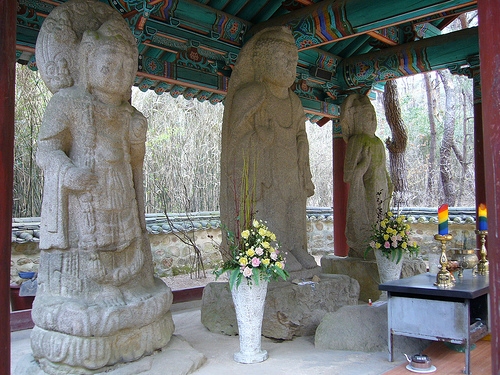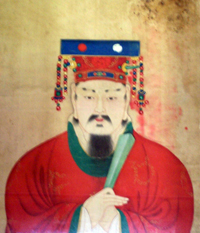|
Gyeongju Seokbinggo
The Gyeongju Seokbinggo is a ''seokbinggo'' or ice house located in the neighborhood of Inwang-dong, Gyeongju, North Gyeongsang province, South Korea. It literally means "stone ice storage" in Korean.Gyeongju seokbinggo at ''Gyeongju Seokbinggo'' was originally built as a wooden storage in the Wolseong Fortress by the ''buyun'' (부윤, county magistrate) Jo Myeong-gyeom (조명겸) in 1738, the 14th year of 's reign during the < ... [...More Info...] [...Related Items...] OR: [Wikipedia] [Google] [Baidu] |
Ice House (building)
An ice house, or icehouse, is a building used to store ice throughout the year, commonly used prior to the invention of the refrigerator. Some were underground chambers, usually man-made, close to natural sources of winter ice such as freshwater lakes, but many were buildings with various types of insulation. During the winter, ice and snow would be cut from lakes or rivers, taken into the ice house, and packed with insulation (often straw or sawdust). It would remain frozen for many months, often until the following winter, and could be used as a source of ice during the summer months. The main application of the ice was the storage of foods, but it could also be used simply to cool drinks, or in the preparation of ice-cream and sorbet desserts. During the heyday of the ice trade, a typical commercial ice house would store of ice in a and building. History A cuneiform tablet from c. 1780 BC records the construction of an icehouse by Zimri-Lim, the King of Mari, in the n ... [...More Info...] [...Related Items...] OR: [Wikipedia] [Google] [Baidu] |
Tourism In Gyeongju
Tourism in Gyeongju is a major industry and defining feature of Gyeongju, South Korea. Gyeongju is a major cultural site and tourist destination for South Koreans and foreigners with about 8 to 9 million visitors annually. A great deal of this is due to the city's status as a center of Silla heritage, derived from its former role as the capital of that ancient kingdom. Silla remains Many Silla sites are included in Gyeongju National Park. In addition, the Gyeongju National Museum hosts many artifacts from the Silla kingdom which have been excavated from sites within the city and surrounding areas, including several royal crowns and other national treasures. Some of Gyeongju's most famous sites relate to the Silla government's patronage of Buddhism. The grotto of Seokguram and the temple of Bulguksa were the first Korean sites to be included on the UNESCO World Heritage List, in 1995. In addition, the ruins of the old Hwangnyongsa temple, said to have been Korean's largest, are ... [...More Info...] [...Related Items...] OR: [Wikipedia] [Google] [Baidu] |
Treasures Of South Korea
The heritage preservation system of South Korea is a multi-level program aiming to preserve and cultivate Korean cultural heritage. The program is administered by the Cultural Heritage Administration (CHA; 대한민국 문화재청, Daehan Minguk Munhwa Jaecheong), and the legal framework is provided by the Cultural Heritage Protection Act of 1962, last updated in 2012. The program started in 1962 and has gradually been extended and upgraded since then. The CHA classifies cultural heritage into five major categories (state-designated heritage, city and province-designated heritage, cultural heritage material, registered cultural heritage, undesignated cultural heritage) and these are divided further into subcategories. Besides tangible cultural heritage, South Korea aims to preserve its intangible cultural heritage as well, including folk customs, music, dance and handicraft. The program also includes Living National Treasures, persons who possess the knowledge and skills importa ... [...More Info...] [...Related Items...] OR: [Wikipedia] [Google] [Baidu] |
Joseon Dynasty
Joseon (; ; Middle Korean: 됴ᇢ〯션〮 Dyǒw syéon or 됴ᇢ〯션〯 Dyǒw syěon), officially the Great Joseon (; ), was the last dynastic kingdom of Korea, lasting just over 500 years. It was founded by Yi Seong-gye in July 1392 and replaced by the Korean Empire in October 1897. The kingdom was founded following the aftermath of the overthrow of Goryeo in what is today the city of Kaesong. Early on, Korea was retitled and the capital was relocated to modern-day Seoul. The kingdom's northernmost borders were expanded to the natural boundaries at the rivers of Amrok and Tuman through the subjugation of the Jurchens. During its 500-year duration, Joseon encouraged the entrenchment of Confucian ideals and doctrines in Korean society. Neo-Confucianism was installed as the new state's ideology. Buddhism was accordingly discouraged, and occasionally the practitioners faced persecutions. Joseon consolidated its effective rule over the territory of current Korea and saw the ... [...More Info...] [...Related Items...] OR: [Wikipedia] [Google] [Baidu] |
Infrastructure Completed In 1738
Infrastructure is the set of facilities and systems that serve a country, city, or other area, and encompasses the services and facilities necessary for its economy, households and firms to function. Infrastructure is composed of public and private physical structures such as roads, railways, bridges, tunnels, water supply, sewers, electrical grids, and telecommunications (including Internet connectivity and broadband access). In general, infrastructure has been defined as "the physical components of interrelated systems providing commodities and services essential to enable, sustain, or enhance societal living conditions" and maintain the surrounding environment. Especially in light of the massive societal transformations needed to mitigate and adapt to climate change, contemporary infrastructure conversations frequently focus on sustainable development and green infrastructure. Acknowledging this importance, the international community has created policy focused on sustain ... [...More Info...] [...Related Items...] OR: [Wikipedia] [Google] [Baidu] |
Buildings And Structures In Gyeongju
A building, or edifice, is an enclosed structure with a roof and walls standing more or less permanently in one place, such as a house or factory (although there's also portable buildings). Buildings come in a variety of sizes, shapes, and functions, and have been adapted throughout history for a wide number of factors, from building materials available, to weather conditions, land prices, ground conditions, specific uses, prestige, and aesthetic reasons. To better understand the term ''building'' compare the list of nonbuilding structures. Buildings serve several societal needs – primarily as shelter from weather, security, living space, privacy, to store belongings, and to comfortably live and work. A building as a shelter represents a physical division of the human habitat (a place of comfort and safety) and the ''outside'' (a place that at times may be harsh and harmful). Ever since the first cave paintings, buildings have also become objects or canvasses of much artis ... [...More Info...] [...Related Items...] OR: [Wikipedia] [Google] [Baidu] |
Architecture Of Korea
Korean architecture () refers to an architectural style that developed over centuries in Korea. Throughout the history of Korea, various kingdoms and royal dynasties have developed a unique style of architecture with influences from Buddhism and Korean Confucianism. Just like in the case of other Korean arts, Korean architecture is distinguished by its naturalistic tendencies, simplicity, economy of shape, and avoidance of extremes. General characteristics In Korean architecture, buildings are structured vertically and horizontally. A construction usually rises from a stone subfoundation to a curved roof covered with tiles, held by a console structure and supported on posts; walls are made of earth (adobe) or are sometimes totally composed of movable wooden doors. Architecture is built according to the kan unit, the distance between two posts (about 3.7 meters), and is designed so that there is always a transitional space between the "inside" and the "outside." The console, ... [...More Info...] [...Related Items...] OR: [Wikipedia] [Google] [Baidu] |
Joseon Dynasty
Joseon (; ; Middle Korean: 됴ᇢ〯션〮 Dyǒw syéon or 됴ᇢ〯션〯 Dyǒw syěon), officially the Great Joseon (; ), was the last dynastic kingdom of Korea, lasting just over 500 years. It was founded by Yi Seong-gye in July 1392 and replaced by the Korean Empire in October 1897. The kingdom was founded following the aftermath of the overthrow of Goryeo in what is today the city of Kaesong. Early on, Korea was retitled and the capital was relocated to modern-day Seoul. The kingdom's northernmost borders were expanded to the natural boundaries at the rivers of Amrok and Tuman through the subjugation of the Jurchens. During its 500-year duration, Joseon encouraged the entrenchment of Confucian ideals and doctrines in Korean society. Neo-Confucianism was installed as the new state's ideology. Buddhism was accordingly discouraged, and occasionally the practitioners faced persecutions. Joseon consolidated its effective rule over the territory of current Korea and saw the ... [...More Info...] [...Related Items...] OR: [Wikipedia] [Google] [Baidu] |
Gyeongju
Gyeongju ( ko, 경주, ), historically known as ''Seorabeol'' ( ko, 서라벌, ), is a coastal city in the far southeastern corner of North Gyeongsang Province in South Korea. It is the second largest city by area in the province after Andong, covering with a population of 264,091 people (as of December 2012.) Gyeongju is southeast of Seoul, and east of Daegu. The city borders Cheongdo and Yeongcheon to the west, Ulsan to the south and Pohang to the north, while to the east lies the coast of the Sea of Japan. Numerous low mountains—outliers of the Taebaek range—are scattered around the city. Gyeongju was the capital of the ancient kingdom of Silla (57 BC – 935 AD), which ruled about two-thirds of the Korean Peninsula at its height between the 7th and 9th centuries, for close to one thousand years. Later Silla was a prosperous and wealthy country, and its metropolitan capital of Gyeongju was the fourth largest city in the world. A vast number of archaeological sites an ... [...More Info...] [...Related Items...] OR: [Wikipedia] [Google] [Baidu] |
Yeongjo Of Joseon
Yeongjo of Joseon (31 October 1694 – 22 April 1776), personal name Yi Geum (Korean language, Korean: 이금, Hanja: 李昑), was the 21st monarch of the Joseon, Joseon dynasty of Korea. He was the second son of Sukjong of Joseon, King Sukjong, by his concubine Royal Noble Consort Sukbin Choe, Royal Noble Consort Suk of the Haeju Choe clan. Before ascending to power, he was known as Prince Yeoning (Korean language, Korean: 연잉군, Hanja: 延礽君). His life was characterized by political infighting and resentment due to his biological mother's Cheonmin, low-born origins. In 1720, a few months after the accession of his older half-brother, Gyeongjong of Joseon, Yi Yun (posthumously called Gyeongjong of Joseon, King Gyeongjong), as the 20th King, Yeoning became the Crown Prince. This induced a large controversy between the Political faction, political factions. Nevertheless, four years later, at the death of Gyeongjong, he ascended to the throne. Yeongjo's reign lasted nearl ... [...More Info...] [...Related Items...] OR: [Wikipedia] [Google] [Baidu] |
Wolseong Fortress
Wolseong Palace Site, Gyeongju (慶州 月城, literally “Half Moon Fortress”), also commonly known as Wolseong Palace, was the royal palace compound of the Korean Silla monarchy at their capital in Gyeongju during the Silla and Unified Silla periods (57 BCE-938 CE). It takes its name from the approximate outline of the palace walls which were shaped like a crescent moon. Banwolseong has been also known as Sinwolseong or Jaeseong, which means where the king resides. Features Today the ruins of the palace, set among lush forests and hills, can still be visited and is part of the Gyeongju Historic Areas, a UNESCO World Heritage site. The South Korean government has also designated the palace ruins as Historic Site No. 16. Other notable sites nearby include the Anapji Pond which is northwest of the ruins and Gyeongju National Museum. According to the ''Samguk Sagi'', the fortress was built by King Pasa (4-24) to protect the royal palace. However, excavations done at the ... [...More Info...] [...Related Items...] OR: [Wikipedia] [Google] [Baidu] |





